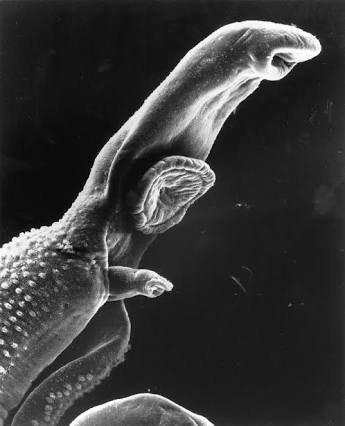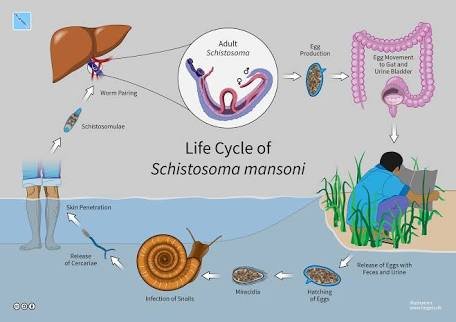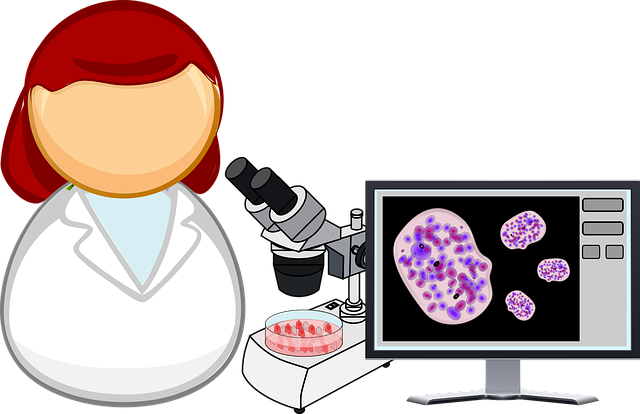Schistosomiasis: A Deadly Disease Second To Malaria

Image Source
Over 400 million people across the globe are infected with either urinary or intestinal diseases or both, with rising rate of mortality among theses affected population. Large percentage of the urinary and intestinal diseases is cause by Schistosomiasis.
About Schistosomiasis
Schistosomiasis is a deadly disease caused by a parasite called blood fluke (also known as schistome). It is called blood fluke because it occurs in the blood (specifically in blood vessels) of the target affected. The disease affects the human, mice, cat, dog, rabbit and guinea pig population.
Geographical Distribution

Image Source
Schistosomiasis is not present in all regions but some regions of the world affecting mostly the rural settlements. The regions where the disease is distributed include;
All region in Africa
North-East region of South America
Middle East region of Asia
Schistosomiasis is distributed among those regions of the world because of the high presence of aquatic ecosystem and Snails, especially in Africa which places high value on Snails as source of meat.
Process Involved In Its Transmission

Image Source
Blood Flukes, the parasite causing schistosomiasis lives in the urinary blood vessels or intestinal blood vessels of those infected (the victims). These parasites lay egg in the urinary blood vessels or intestinal blood vessel. The blood that flows in these blood vessels transports the eggs to mix up with urine or faeces. The urine and faeces is both excreted out of the body together with the eggs into the environment. Under favourable conditions (presences of moisture, light and optimum temperature of 28 degree Celsius) the egg hatch into living organism known as miracidium. The miracidum becomes attracted to snails and penetrate into the tissues of snail. In the tissues of snail it develops into an organism called cercaria. When development is complete, the cercaria leaves the tissue of the Snail and enters into an aquatic ecosystem or any open water body. During human activities that involves aquatic system, the cercaria penetrates the skin of an uninfected victim by digesting the skin with lytic enzymes. After penetrating the skin of the uninfected victim, it develops into the main blood fluke. The blood fluke penetrate the blood vessels and the blood transports them to the urinary or intestinal blood vessels where they settle there as their habitat.
In summary of the process of transmission, it is very important to note two things:
The disease and its parasite is transmitted from infected individuals through their urine and faeces.
Snails facilitate the effective transmission of the disease. Therefore without snails, the transmission would not be effective.
Human Health Effect
The disease has the following effect on the human health;
Haematuria - A condition with presence of blood in urine.
Uraemia - Kidney failure to eliminate metabolic waste from the body.
Infertility
Enlargement of the liver
Abnormal intestinal pain
Diarrhoea - a frequent condition of watery stool.
Diagnosis:

image Source
The disease can be diagnosed through laboratory analysis of urine and faeces. Presence of blood fluke eggs indicates a most conclusive evidence for being infected with the disease. This should be treated appropriately by a qualified and experienced medical personnel.
Prevention and Control Approach
Improving the socio-economic levels of rural settlements is a major prevention / control approach because schistosomiasis mostly affects people of the rural settlements. This is because rural depends on the aquatic system (streams, rivers, ocean) as their source of livelihood for fishing, bathing, laundry, drinking, for refuse dumping and excretion of faeces and urine. If infected individuals visit these aquatic systems in rural settlements, they may excrete infected faeces or urine into the aquatic system. If there is presence of snails in such environment, the transmission of the disease is enhanced. Therefore provision of rural settlement with amenities like good toilet system, drilled bore hole water will be a boost in the prevention and control of schistosomiasis.
Treatment of sewage system used in urban settlements before disposal into aquatic system.
References For Further Study
[1] | [2] | [3] | [4]
Schitosomiasis is as deadly as malaria. Be vigilant!
Author's Profile


@vic-essien , Nice article on Schistosomiasis. You have nicely laid out every single piece of information on schistosomiasis in a great way. Being a Microbiologists by profession, I found your post very interesting and that's why I just upvoted the post.
You can also visit and follow me @drvnpatel for more such articles written for biological sciences
Thanks you @drvnpatel for you comment. I am glad you found it interesting as a microbiologist because this is related to your discipline.
I just followed you to get more update on articles relating to my field of biological science.
Cheers
Interesting... No swimming in the river then.
Not totally. Just that river is not 100% safe. Thank you for stopping by.
Please check your article for copyrighted images. For more on that check this post. Thank you.
Hi @greenrun ,
Thanks for your comment and the post link. I found it extremely useful. I do appreciate.
To that effect, i have checked my article for copyrighted images and i have corrected them by replacing them with images labelled for reuse, using the guidance of your post.
You can check it out.
Thank you.
Thank you.